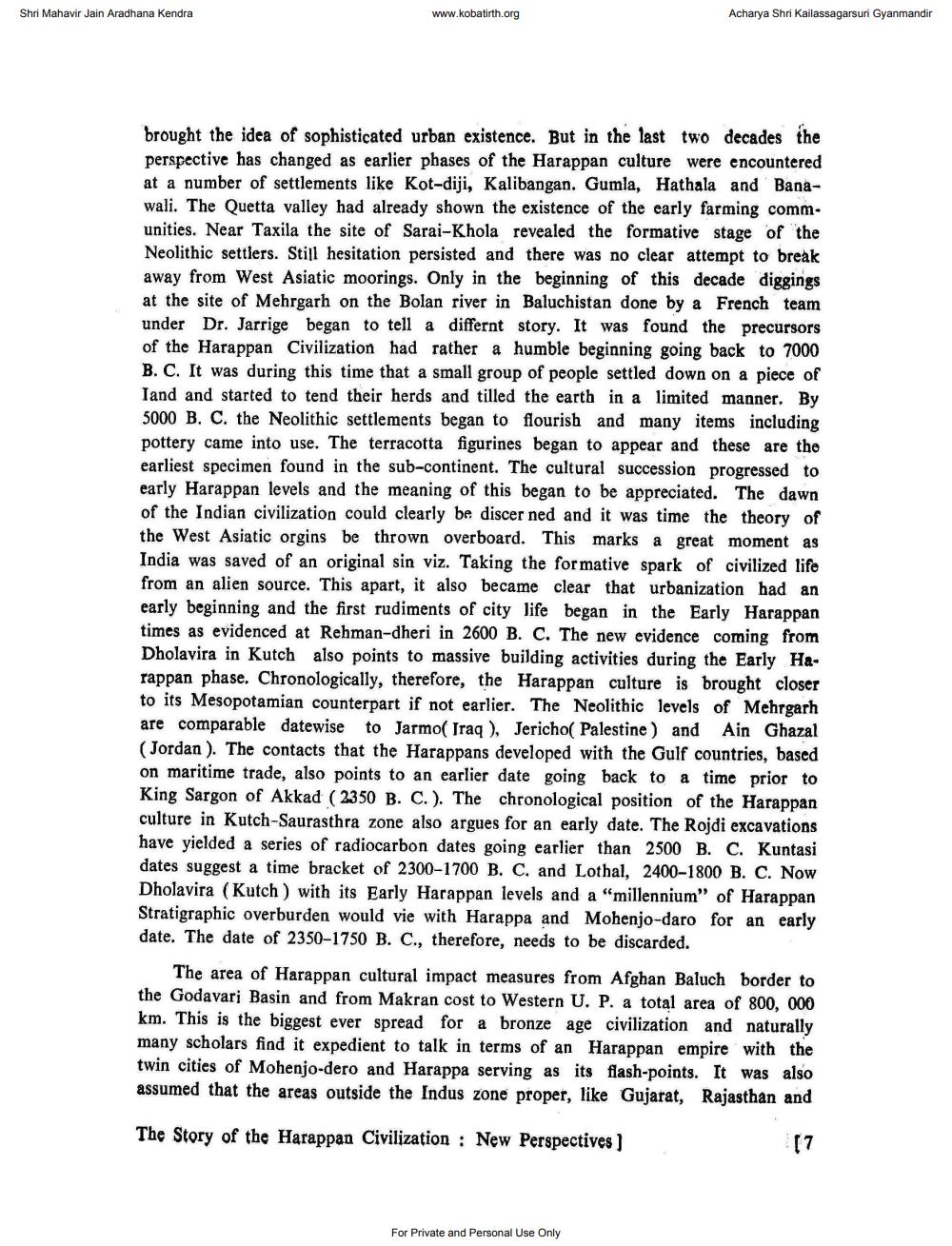Book Title: Samipya 1991 Vol 08 Ank 01 02 Author(s): Pravinchandra C Parikh, Bhartiben Shelat Publisher: Bholabhai Jeshingbhai Adhyayan Sanshodhan Vidyabhavan View full book textPage 9
________________ Shri Mahavir Jain Aradhana Kendra www.kobatirth.org Acharya Shri Kailassagarsuri Gyanmandir brought the idea of sophisticated urban existence. But in the last two decades the perspective has changed as earlier phases of the Harappan culture were encountered at a number of settlements like Kot-diji, Kalibangan. Gumla, Hathala and Banawali. The Quetta valley had already shown the existence of the early farming communities. Near Taxila the site of Sarai-Khola revealed the formative stage of the Neolithic settlers. Still hesitation persisted and there was no clear attempt to break away from West Asiatic moorings. Only in the beginning of this decade diggings at the site of Mehrgarh on the Bolan river in Baluchistan done by a French team under Dr. Jarrige began to tell a differnt story. It was found the precursors of the Harappan Civilization had rather a humble beginning going back to 7000 B. C. It was during this time that a small group of people settled down on a piece of land and started to tend their herds and tilled the earth in a limited manner. By 5000 B. C. the Neolithic settlements began to flourish and many items including pottery came into use. The terracotta figurines began to appear and these are the earliest specimen found in the sub-continent. The cultural succession progressed to early Harappan levels and the meaning of this began to be appreciated. The dawn of the Indian civilization could clearly be discerned and it was time the theory of the West Asiatic orgins be thrown overboard. This marks a great moment as India was saved of an original sin viz. Taking the formative spark of civilized life from an alien source. This apart, it also became clear that urbanization had an early beginning and the first rudiments of city life began in the Early Harappan times as evidenced at Rehman-dheri in 2600 B. C. The new evidence coming from Dholavira in Kutch also points to massive building activities during the Early Harappan phase. Chronologically, therefore, the Harappan culture is brought closer to its Mesopotamian counterpart if not earlier. The Neolithic levels of Mehrgarh are comparable datewise to Jarmo(Iraq), Jericho Palestine ) and Ain Ghazal (Jordan ). The contacts that the Harappans developed with the Gulf countries, based on maritime trade, also points to an earlier date going back to a time prior to King Sargon of Akkad ( 2350 B. C.). The chronological position of the Harappan culture in Kutch-Saurasthra zone also argues for an early date. The Rojdi excavations have yielded a series of radiocarbon dates going earlier than 2500 B. C. Kuntasi dates suggest a time bracket of 2300-1700 B. C. and Lothal, 2400-1800 B. C. Now Dholavira (Kutch ) with its Early Harappan levels and a "millennium" of Harappan Stratigraphic overburden would vie with Harappa and Mohenjo-daro for an early date. The date of 2350-1750 B. C., therefore, needs to be discarded. The area of Harappan cultural impact measures from Afghan Baluch border to the Godavari Basin and from Makran cost to Western U. P. a total area of 800, 000 km. This is the biggest ever spread for a bronze age civilization and naturally many scholars find it expedient to talk in terms of an Harappan empire with the twin cities of Mohenjo-dero and Harappa serving as its flash-points. It was also assumed that the areas outside the Indus zone proper, like Gujarat, Rajasthan and The Story of the Harappan Civilization : New Perspectives For Private and Personal Use OnlyPage Navigation
1 ... 7 8 9 10 11 12 13 14 15 16 17 18 19 20 21 22 23 24 25 26 27 28 29 30 31 32 33 34 35 36 37 38 39 40 41 42 43 44 45 46 47 48 49 50 51 52 53 54 55 56 57 58 59 60 61 62 63 64 65 66 67 68 69 70 71 72 73 74 75 76 77 78 79 80 81 82 83 84 85 86 87 88 89 90 91 92 ... 134
